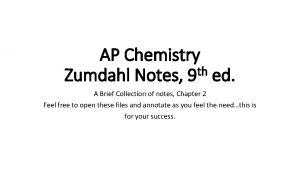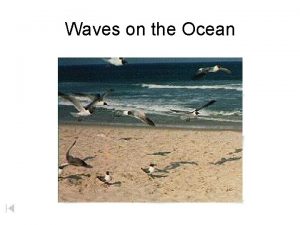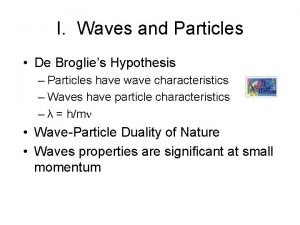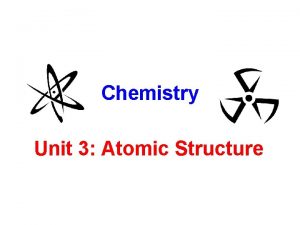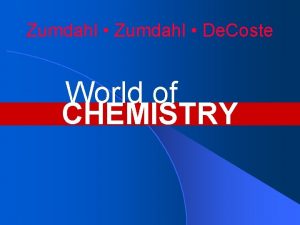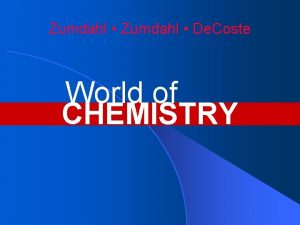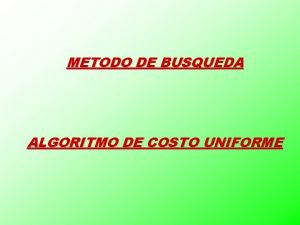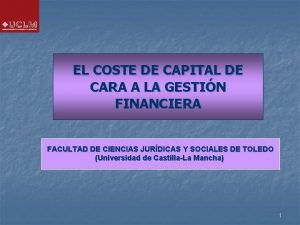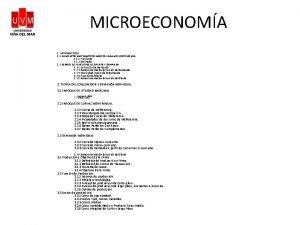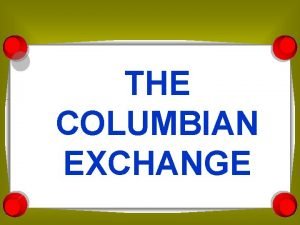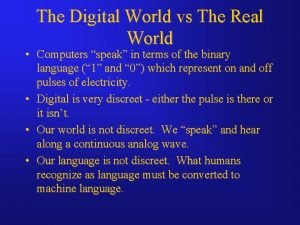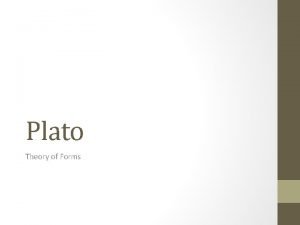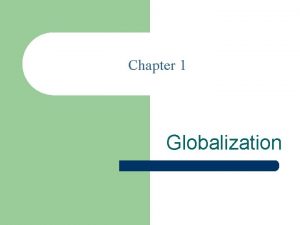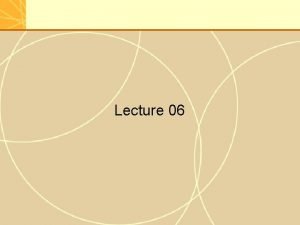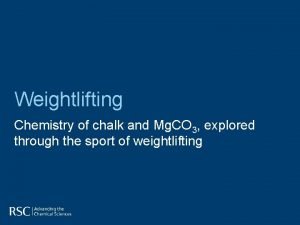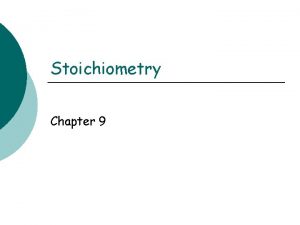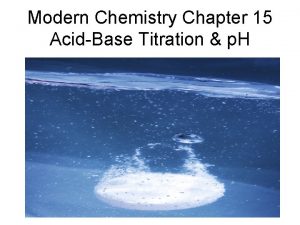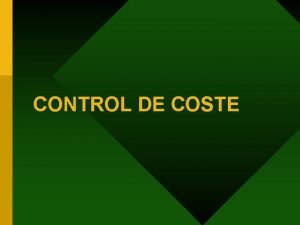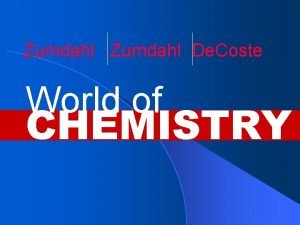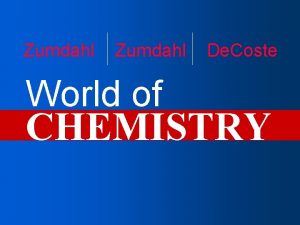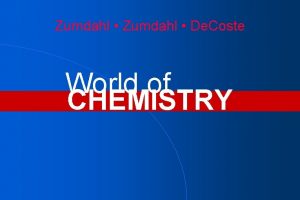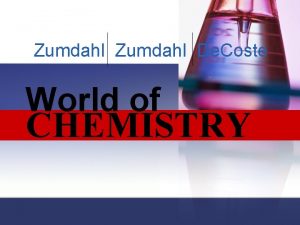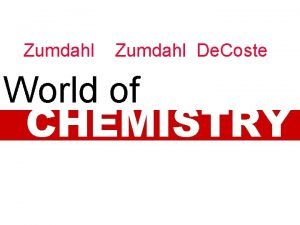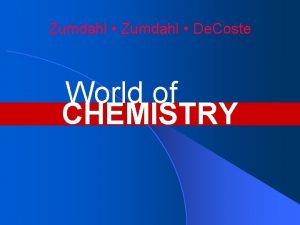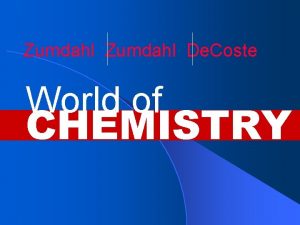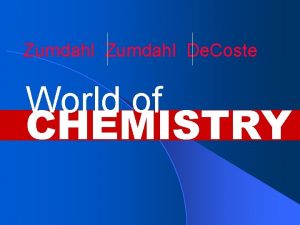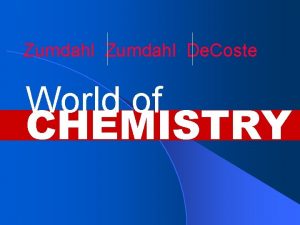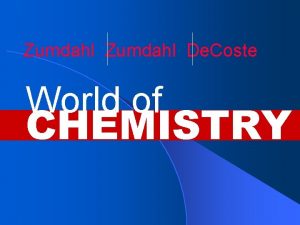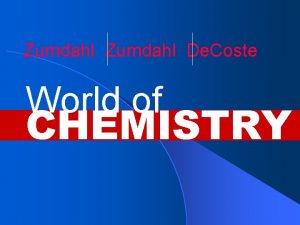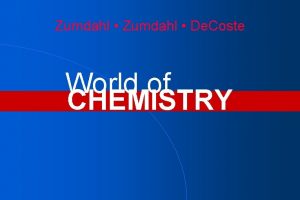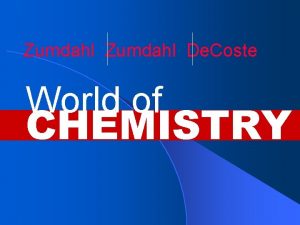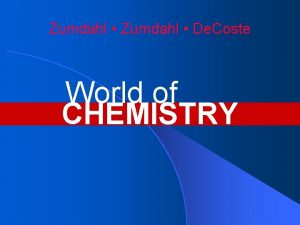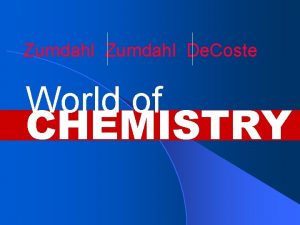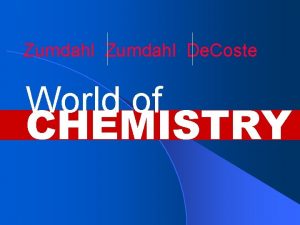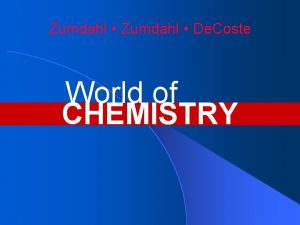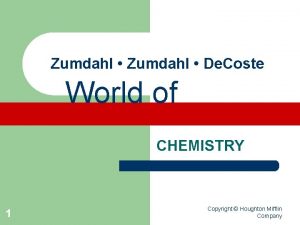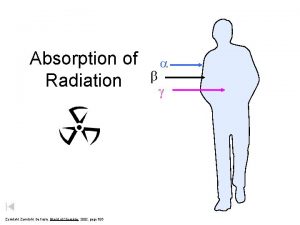Zumdahl De Coste World of CHEMISTRY Chapter 13


































- Slides: 34

Zumdahl De. Coste World of CHEMISTRY

Chapter 13 Gases Copyright© by Houghton Mifflin Company. All rights reserved.

Chapter 13 Overview l l l Atmospheric Pressure/Barometers Units of pressure Boyle’s Law Charles’ Law/Absolute Zero Avogadro’s Law Ideal Gas Law Partial/Total Pressure Relationship between laws and models Kinetic Molecular Theory Meaning of Temperature Properties of real gases Molar Volume of Ideal Gas/STP Copyright© by Houghton Mifflin Company. All rights reserved. 3

Properties of Gases l Uniformly fills any container l Easily compressed l Mixes completely with other gases l Exerts pressure on surroundings – Blow up balloon, pushes on elastic sides keeping it firm – Atmosphere exerts pressure Copyright© by Houghton Mifflin Company. All rights reserved. 4

Torricelli’s Barometer Figure 13. 2: A glass tube is filled with mercury and inverted in a dish of mercury at sea level. Barometer: device that measures atmospheric pressure Atmospheric pressure results from the mass of the air being pulled toward the center of the earth by gravity (in other words, the weight of the air above us) Copyright© by Houghton Mifflin Company. All rights reserved. 5

Units of Pressure l torr = mm of Hg (named after Torricelli) l 1 std atmosphere = 1 atm = 760 mm Hg l SI unit for pressure = Pascal (Pa) l 1 atm = 101, 325 Pa = 101. 325 k. Pa l In engineering, use psi: 1 atm = 14. 69 psi Copyright© by Houghton Mifflin Company. All rights reserved. 6

Figure 13. 3: Gas pressure = atmospheric pressure – h. Copyright© by Houghton Mifflin Company. All rights reserved. 7

Figure 13. 3: Gas pressure = atmospheric pressure + h. Copyright© by Houghton Mifflin Company. All rights reserved. 8

Boyle’s Law l Boyle was first to perform careful experiments on gases l Studied relationship between the pressure of a trapped gas and its volume l As pressure increased, volume decreased l Analyzing data on next slide, as pressure doubles, volume is cut in half Copyright© by Houghton Mifflin Company. All rights reserved. 9

Table 13. 1 Copyright© by Houghton Mifflin Company. All rights reserved. 10

Figure 13. 4: A J -tube similar to the one used by Boyle. Copyright© by Houghton Mifflin Company. All rights reserved. 11

Figure 13. 5: A plot of P versus V from Boyle’s data. PV = k Pressure x volume = a constant Pressure and volume are inversely proportional (when one increases, the other decreases) Copyright© by Houghton Mifflin Company. All rights reserved. 12

Figure 13. 6: Illustration of Boyle’s law. Note: Temperature & amount of gas remain constant Copyright© by Houghton Mifflin Company. All rights reserved. 13

Calculations using Boyle’s Law l If we have a gas at a certain volume and pressure (V 1 and P 1), we can find the new volume (V 2) if the pressure changes (P 2) or the new pressure if the volume changes Since V 1 P 1 = k and V 2 P 2 = k then V 1 P 1 = V 2 P 2 See Examples 13. 2 and 13. 3 Copyright© by Houghton Mifflin Company. All rights reserved. 14

Charles’ Law: Volume vs. Temperature l Jacques Charles – first to fill balloon with hydrogen gas & made 1 st solo balloon flight l Showed volume of a given gas (at constant pressure) increases as the temperature increases l Plot of volume of given gases versus temperature gives straight line = linear relationship (see next slide) Copyright© by Houghton Mifflin Company. All rights reserved. 15

Figure 13. 7: Plots of V (L) versus T (°C) for several gases. All lines extrapolate back to -273°C = absolute zero Lower temperature would result in negative volume which is impossible Cannot cool matter below this temperature Copyright© by Houghton Mifflin Company. All rights reserved. 16

Figure 13. 8: Plots of V versus T using the Kelvin scale for temperature. Volume is directly proportional to temperature (if temp doubles, volume also doubles) V = b. T b = constant T = temp (K) Copyright© by Houghton Mifflin Company. All rights reserved. 17

Calculations using Charles’ Law Since V = b. T, V/T = b (a constant) So, if V 1/T 1 = b and V 2/T 2 = b then V 1/T 1 = V 1/T 2 See examples 13. 4, 13. 5, and 13. 6 Copyright© by Houghton Mifflin Company. All rights reserved. 18

Avogadro’s Law l The volume of gas is directly proportional to the number of moles if the temperature and pressure are held constant (if volume doubles, number of moles also doubles) V = an V = volume, a = constant, n = # moles Rearranging, V 1/n 1 = a & V/n = a V 2/n 2 = a so V 1/n 1 = V 2/n 2 Copyright© by Houghton Mifflin Company. All rights reserved. 19

Figure 13. 9: The relationship between volume V and number of moles n. Copyright© by Houghton Mifflin Company. All rights reserved. 20

The Ideal Gas Law l l l By combining Boyle’s, Charles’, and Avogadro’s Laws, we obtain the Ideal Gas Law: PV = n. RT The constants in each of these laws are combined to form the universal gas constant, R R = 0. 08206 L atm/K mol Only applies to ideal gases (P is approximately 1 atm or lower & temp is 0°C or higher) See examples 13. 9, 13. 10, and 13. 11 Copyright© by Houghton Mifflin Company. All rights reserved. 21

Combined Gas Law l By combining Boyle's and Charles' Laws, we get the combined gas law P 1 V 1 = P 2 V 2 T 1 T 2

Figure 13. 10: When two gases are present, the total pressure is the sum of the partial pressures of the gases. Copyright© by Houghton Mifflin Company. All rights reserved. 23

Dalton's Law of Partial Pressures l Many important gases are mixtures of components (ex: air, scuba diver tanks) l Summary of Dalton's observations: for a mixture of gases in a container, the total pressure is the sum of the partial pressures of the gases present l Partial pressure: pressure that the gas would exert if it were alone in the container

Ptotal = P 1 + P 2 + P 3 Ptotal = ntotal (RT/V) n = sum of the number of moles of gases in mixture Identity of gas particles is not important

Figure 13. 11: The total pressure of a mixture of gases depends on the number of moles of gas particles present. Copyright© by Houghton Mifflin Company. All rights reserved. 26

Figure 13. 12: The production of oxygen by thermal decomposition. Copyright© by Houghton Mifflin Company. All rights reserved. 27

Ideal vs. Real l At high pressures and/or low temperatures, gases deviate significantly from ideal gas law l At low pressures and/or high temperatures, real gases approach behavior of ideal gas l Ideal gas is hypothetical substance

Postulates of KMT. Copyright© by Houghton Mifflin Company. All rights reserved. 29

Kinetic Molecular Theory l Qualitative analysis (not mathematical) l Temperature reflects how fast particles move – High temp: particles move fast, hit sides of container often – Low temp: particles move slower, hit sides less often – KM theory: temp is directly proportional to kinetic energy – Pressure due to collisions with wall, as temp increases, pressure increases

Figure 13. 13: (a) A gas confined in a cylinder with a movable piston. (b) The temperature of the gas is increased at constant pressure P ext. . Copyright© by Houghton Mifflin Company. All rights reserved. 31

Figure 13. 14: A gas sample is compressed. Copyright© by Houghton Mifflin Company. All rights reserved. 32

Real Gases l Ideal gas: hypothetical substance consisting of particles with zero volume and no attractions for one another l Behave like ideal gases under many conditions l High pressure: molecules closer and more likely to attract, does not obey ideal gas law

Gas Stoichiometry l Can use ideal gas law to convert from moles to volumes l One mole of any gas at STP (standard temperature and pressure) occupies 22. 4 L = molar volume – Standard temperature = 0°C = 273 K – Standard pressure = 1 atm
 Zumdahl chemistry, 9th edition notes
Zumdahl chemistry, 9th edition notes F=lambda/c
F=lambda/c Zumdahl chemistry
Zumdahl chemistry Ion dipole intermolecular forces
Ion dipole intermolecular forces Electron cloud model
Electron cloud model Zumdahl chapter 4
Zumdahl chapter 4 Zumdahl chapter 12
Zumdahl chapter 12 Algoritmo costo uniforme
Algoritmo costo uniforme Coste explícito
Coste explícito Coste marginal
Coste marginal Mural uv
Mural uv Il mare di baffin lambisce le coste
Il mare di baffin lambisce le coste Ib organic chemistry functional groups
Ib organic chemistry functional groups Inorganic vs organic chemistry
Inorganic vs organic chemistry Ap world history chapter 25 africa and the atlantic world
Ap world history chapter 25 africa and the atlantic world Primate traits
Primate traits Are oranges old world or new world
Are oranges old world or new world Real world vs digital world
Real world vs digital world Plato theory of forms
Plato theory of forms The changing world output and world trade picture
The changing world output and world trade picture Dangerous world tour history world tour - hockenheimring
Dangerous world tour history world tour - hockenheimring What plots the maps of the slum children
What plots the maps of the slum children An elementary school classroom in a slum by stephen spender
An elementary school classroom in a slum by stephen spender Unit 9 english in the world looking back
Unit 9 english in the world looking back The changing world output and world trade picture
The changing world output and world trade picture Is chalk natural or manmade
Is chalk natural or manmade Chemistry chapter 9 stoichiometry
Chemistry chapter 9 stoichiometry Thermodynamic vs kinetic control
Thermodynamic vs kinetic control Introduction to organic chemistry
Introduction to organic chemistry Chapter 9 review stoichiometry section 3
Chapter 9 review stoichiometry section 3 Chapter 7 review modern chemistry answers
Chapter 7 review modern chemistry answers Modern chemistry chapter 15
Modern chemistry chapter 15 Chapter 14 review acids and bases section 1
Chapter 14 review acids and bases section 1 Chapter 13 ions in aqueous solutions
Chapter 13 ions in aqueous solutions Chapter 12 review solutions section 3
Chapter 12 review solutions section 3
